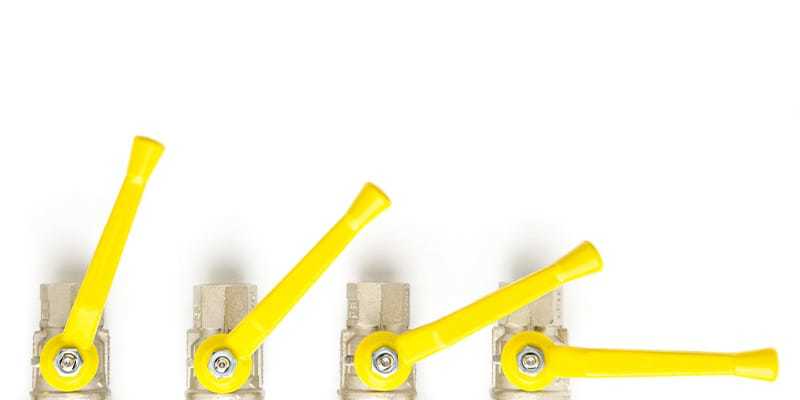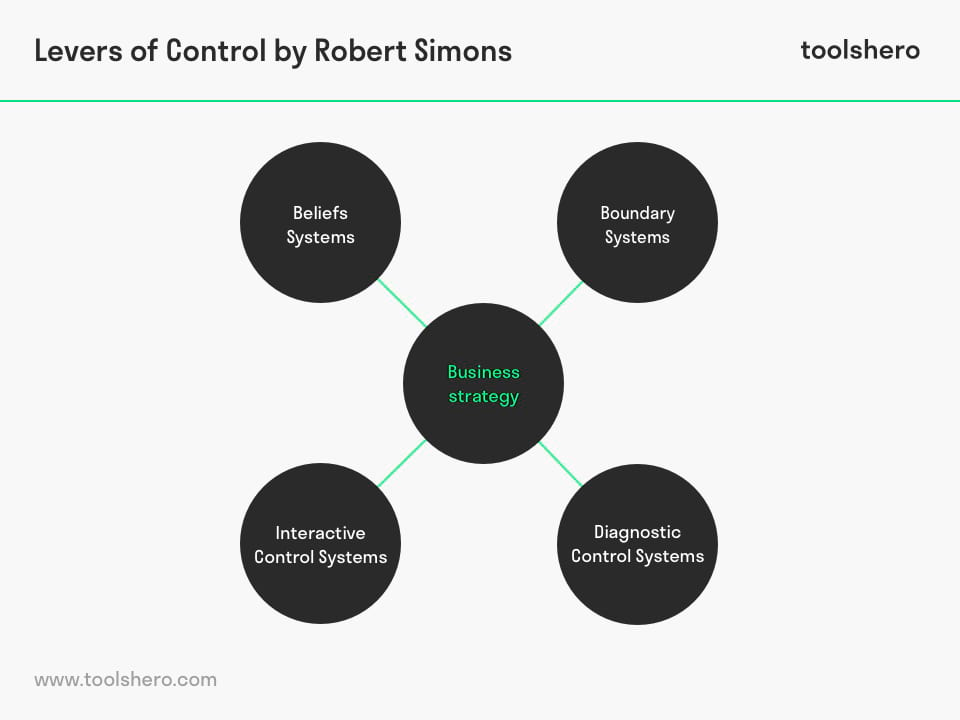Levers of Control model (Simons)

Levers of Control: this article explains the Levers of Control model, developed by Robert Simons, in a practical way. After reading it, you understand the basics of this strategy and management related tool.
What is the Levers of Control model?
For many organisations, it is of great importance that a balance is found between managing and controlling an organisation. It concerns a management control system, or MCS for short.
It was the American economist and Harvard professor Robert Simons who made an important contribution to this by introducing the so-called Levers of Control (LOC) in his book ‘Levers of Control‘ in 1995.
The Levers of Control model contains four instruments that can serve as a lever to better control an organisation. Simons focused specifically on activities that are meant to achieve the organisation’s strategic objectives.
MCS and LOC are not only meant to change behaviour, but also to implement strategic changes.
Levers of Control: objectives and behaviour
The Levers of Control model is characterised by the two elements ‘objectives‘ and ‘behaviour’. First of all, an organisation must have an objective that is being pursued and that directly relates to the core business.
In addition, employee behaviour is crucial; after all, it has to contribute to the company’s previously set objectives. The four levers are control factors that keep the organisation in balance with regard to the previously mentioned objectives and behaviour.
However, the Levers of Control model assumes that the organisation’s objectives may change as a result of strategy changes. An organisation is a part of its environment and this environment can certainly influence it in such a way that an organisation is compelled to change its strategy. Levers of Control has an interactive role in this and can contribute to strategy change.
Levers of Control are all about balance
All four levers keep the organisation in balance. When one lever becomes ‘heavier’, the organisation tilts in that direction and loses balance. Therefore all levers must be given equal attention in order to keep the strategic balance of the organisation in check.
According to Simons, it’s all about managing tensions between freedom and limitation, authorisation and accountability, top-down and bottom-up management, creativity, experimentation, and efficiency. All these areas of tension can be found in the Levers of Control framework, as long as there is a balance between the four levers.
For example, an organisation with too many Boundary Systems will miss certain opportunities and focus too much on rules and procedures. An organisation with too strong an emphasis on Belief Systems runs the risk of losing its reputation because employees do not behave as part of the organisation and do not properly represent it.
In all these cases, it is necessary to find a good balance. All four levers are explained below:
1. Diagnostic Control Systems
This lever is used to check whether the organisation complies with the strategic plan and whether adjustments are needed. Controls are in place to ensure that everything runs smoothly, including Key Performance Indicators (KPIs), Return on Investment (ROI), and quarterly figures.
Formal information-based routines and procedures are in place to maintain and/or change organisational activities. By means of budget and project management systems, managers are made responsible and monitored on the output of their departments and divisions. Each management layer knows which requirements need to be met. Good performance is rewarded and control is clear.
2. Interactive Control Systems
These are formal consultations with the aim to come up with new ideas and strategies. The focus is on innovation to potentially address strategic uncertainties and to change the strategy.
This lever is the result of permanent communication between the top management and other management layers. In this way, each hierarchical layer knows what is going on and whether the chosen strategy is still being followed.
The organisation can respond successfully to changes by being alert to the environment. However, according to Simons, as soon as Interactive Control starts putting out fires, it gradually becomes Emergent Strategy, and the risk arises that people lose sight of the core business.
3. Beliefs Systems
In the Levers of Control model, this lever determines the direction and concerns the mission and vision of the organisation. The mission must ensure that everyone within the organisation has enough intrinsic motivation to exude the values of the organisation.
While Diagnostic and Interactive Control Systems mainly focus on objectives, Beliefs and Boundary Systems focus on employee behaviour. The Belief Systems must encourage employees to look for opportunities for the organisation.
Their loyalty can be rewarded by extrinsic stimuli in the form of monetary rewards through targets and bonuses. The aim is for everyone within the organisation to display the desired behaviour. The Beliefs Systems formulate the basic values, standards, and beliefs of the organisation; this partly concerns the organisational culture.
4. Boundary Systems
This lever focuses on the boundaries within which every employee should work. These include rules of conduct, formal requirements, procedures, and limits, including credible sanctions that can be imposed if necessary.
All these formal standards limit the behaviour of employees and guide them. This concerns all kinds of codes of conduct that can differ from one organisation to another.
Think of, for example, legal and ethical guidelines or guidelines for preventing unacceptable behaviour. All employees also need to know which privacy-sensitive client information they may or may not share.
Levers of Control: a contingency approach
The entire Levers of Control framework is based on finding the right balance within an organisation. These include rules of conduct, formal requirements, procedures and limits, including credible sanctions that can be imposed if they are exceeded.
Simons also indicates that there is always a link with this environment. The so-called ‘quota approach’ states that there are six factors that can influence it:
- External environment, which can lead to (un)predictable changes;
- Technology, which is becoming increasingly complex and rapidly changing;
- Organisational structure, which is often determined by an organisation itself, but in the event of centralisation, it completely removes the independence of the divisions. As a result, powers and responsibilities are classified differently;
- Scope, which in large organisations leads to a greater distance between departments and makes it more difficult to keep all levers in balance;
- Strategy, which leads to a certain type of competitive strategy, in which the deployment of the various levers can change;
- Culture, which plays a major role in Beliefs Systems in particular and can have a major impact on the balance within the organisation; a people-focused culture has other priorities than a result-focused culture.
Levers of Control model practical Example
A large insurance company focuses on clear business processes; this is logical because procedures and regulations are determined by legislation. Well-trained and knowledgeable employees are employed at every level. The culture is result oriented. The Levers of Control framework for all four levers will be as follows:
Diagnostic Control System
The insurance company is focused on making a profit and keeps a close eye on whether it works according to qualitative standards. The organisation is audited by the government and has to work according to imposed standards and legislation. If too much emphasis is placed on this, balance is lost.
Interactive Control Systems
This plays a major role; the external environment is changing rapidly, leading to different legislation. Technology is also becoming more and more important, with the result that a lot of work on an operational level will be taken over by automation.
Beliefs Systems
Every employee knows what the company stands for and communicates this to customers. When jobs are put at risk by automation, there is a chance that employees are less motivated and no longer act as a true representative of the organisation.
Boundary Systems
All policies and procedures that employees are required to adhere to include legislation set by the insurance company. Nevertheless, they are also required to maintain confidentiality with regard to customer information.
As soon as the organisation implements automation, but does not pay sufficient attention to the interests of the employees, the rules of conduct are jeopardised, and there is a chance that employees won’t take it seriously.
Now it’s your turn
What do you think? Do you recognize the explanation of the Levers of Control model? What do you think are success factors to better control an organization and achieve strategic goals? Do you have any tips or comments?
Share your experience and knowledge in the comments box below.
More information
- Simons, R. (1994). How new top managers use control systems as levers of strategic renewal. Strategic management journal, 15(3), 169-189.
- Simons, R. (1994). Levers of control: How managers use innovative control systems to drive strategic renewal. Harvard Business Press.
- Simons, R. (1995). Control in an age of empowerment. Harvard business review, 73(2), 80-88.
How to cite this article:
Mulder, P. (2019). Levers of Control model (Simons). Retrieved [insert date] from Toolshero: https://www.toolshero.com/strategy/levers-of-control-model/
Original publication date: 09/09/2019 | Last update: 08/23/2023
Add a link to this page on your website:
<a href=”https://www.toolshero.com/strategy/levers-of-control-model/”>Toolshero: Levers of Control model (Simons)</a>













